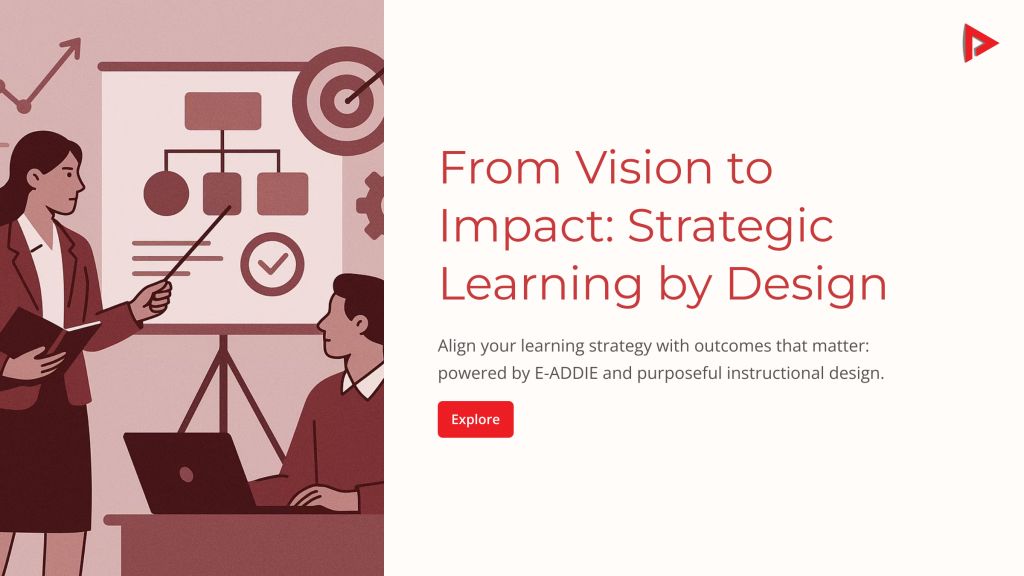
An effective instructional design strategy ensures that learning drives real-world impact across teams and organisations. When training is developed in isolation from strategic goals, it often results in low engagement and limited knowledge retention. The reality is that disconnected programmes may tick compliance boxes but rarely influence behaviour or improve performance at scale.
Table of Contents
Learning and development (L&D) functions are increasingly accountable for supporting business agility and measurable outcomes. When instructional design is tightly aligned with organisational objectives, it becomes a catalyst for change.
The Role of Instructional Design Strategy in Driving Organisational Performance
Instructional design plays a pivotal role in translating business objectives into meaningful learning experiences that drive workplace performance.
At the heart of this process is a deep understanding of how adults learn, what motivates behaviour change, and how to design interventions that stick. Instructional designers use insights from cognitive science, behavioural psychology, and data analytics to shape solutions that go beyond knowledge transfer: they enable action.
Through focusing on outcomes rather than outputs, instructional design empowers organisations to build capability and reduce risk. For sectors like energy or healthcare, where precision and compliance are critical, this approach can directly impact safety and operational continuity.
Turning Strategy into Action: The Instructional Design Process
The instructional design process is where organisational ambition becomes actionable, turning insights into outcomes through structured, human-centred design.
It begins with a robust needs analysis. Rather than jumping straight into solution mode, instructional designers start by identifying the root of the challenge: What performance gap exists? What behaviours need to change? What does success look like from the organisation’s point of view? This diagnostic phase ensures learning is targeted, relevant, and grounded in real-world context.
From there, clear learning objectives are crafted to align with key organisational outcomes. These objectives guide every aspect of the design, whether it’s microlearning for field technicians or scenario-based simulations for leadership development. Inclusive design principles ensure accessibility across diverse roles, while agile methodologies allow for rapid iteration and refinement.
Inside the E-ADDIE Method: Anderson Studios’ Strategic Approach to Learning Design
Anderson Studios has evolved the traditional ADDIE model into something more purposeful: E-ADDIE. By embedding an “Engage” phase before analysis begins, as well as throughout, we create space for alignment, active collaboration, and strategic clarity from day one.
E-ADDIE ensures every project is co-created with the client, shaped by real needs, and guided by measurable outcomes.
The Six Phases of E-ADDIE
1. ENGAGE – Define Direction Early
This pre-analysis phase establishes trust, clarity, and scope before design work begins.
Key steps:
- Host discovery consultations (in person or virtual)
- Complete a pre-analysis questionnaire to determine learning architecture
- Create a detailed Scoping Document (goals, audience, tools, timelines)
- Share proposal with indicative costing
- Confirm tools (e.g. Rise, Storyline) and eLearning level (1, 2, or 3)
Outcome: A shared understanding of vision, deliverables, and next steps—plus client approval to proceed.
2. ANALYSE – Understand the Learner and the Landscape
This phase uncovers learner needs and content gaps to define instructional goals.
Key steps:
- Conduct gap and audience analysis
- Review existing content and learner data
- Finalise learning outcomes
- Submit a detailed MOU (Memorandum of Understanding)
Outcome: A strong foundation for design, with regular check-ins to keep momentum.
3. DESIGN – Blueprint the Learning Experience
Here, ideas become structure. Design documents and storyboards are developed with accessibility and UX in mind.
Key steps:
- Write scripts and build design documents
- Select media and interaction types
- Facilitate review and feedback sessions
Outcome: A validated learning architecture tailored to audience, platform, and outcomes.
4. DEVELOP – Build, Test, and Refine
Learning assets are created, tested, and refined in close collaboration with clients.
Key steps:
- Develop interactive modules
- Record or animate media
- Conduct internal QA and feedback cycles
Outcome: High-quality, media-rich learning content that’s technically sound and visually engaging.
5. IMPLEMENT – Deliver with Confidence
Rollout is supported with clear documentation and stakeholder training.
Key steps:
- Deliver SCORM files and handover pack
- Assist with LMS upload
- Provide rollout support and troubleshooting
Outcome: A smooth transition from development to deployment, with confidence in launch readiness.
6. EVALUATE – Measure What Matters
Post-launch, we gather insights to assess effectiveness and identify opportunities for optimisation.
Key steps:
- Collect feedback and analytics
- Evaluate impact on learner performance
- Recommend improvements
Outcome: Evidence-based insights that inform future learning strategies.
Strategic Learning Starts with Thoughtful Design
Instructional design is the blueprint for measurable, long-term success. The E-ADDIE method exemplifies how thoughtful collaboration, creative problem-solving, and rigorous planning lead to purposeful learning that delivers real impact.
Anderson Studios designs learning experiences that transform potential into performance. From early engagement to post-launch evaluation, our multidisciplinary team works as your strategic partner every step of the way.
Ready to align your learning strategy with meaningful outcomes?
Get in touch today to explore how Anderson Studios can help you deliver results through expertly designed, creatively inspired learning solutions.

